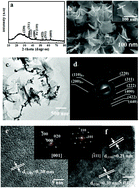Low-temperature hydrothermal synthesis of α-Fe/Fe3O4 nanocomposite for fast Congo red removal
Abstract
A facile low-temperature hydrothermal process to synthesize α-Fe/Fe3O4 nanocomposite is reported.

* Corresponding authors
a Key Laboratory of Automobile Materials (Jilin University), Ministry of Education and School of Materials Science and Engineering, Jilin University, Changchun 130022, China
b
School of Mechanical Science and Engineering, Northeast Petroleum University, Daqing 163318, China
E-mail:
lijunzhao@jlu.edu.cn
Fax: (+86)431-85095876
Tel: (+86)431-85095878
A facile low-temperature hydrothermal process to synthesize α-Fe/Fe3O4 nanocomposite is reported.

 Please wait while we load your content...
Something went wrong. Try again?
Please wait while we load your content...
Something went wrong. Try again?
L. Wang, J. Li, Z. Wang, L. Zhao and Q. Jiang, Dalton Trans., 2013, 42, 2572 DOI: 10.1039/C2DT32245E
To request permission to reproduce material from this article, please go to the Copyright Clearance Center request page.
If you are an author contributing to an RSC publication, you do not need to request permission provided correct acknowledgement is given.
If you are the author of this article, you do not need to request permission to reproduce figures and diagrams provided correct acknowledgement is given. If you want to reproduce the whole article in a third-party publication (excluding your thesis/dissertation for which permission is not required) please go to the Copyright Clearance Center request page.
Read more about how to correctly acknowledge RSC content.
 Fetching data from CrossRef.
Fetching data from CrossRef.
This may take some time to load.
Loading related content
